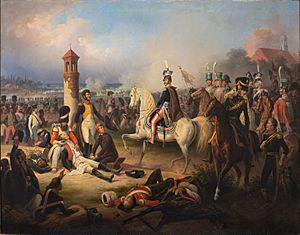Battle of Raszyn (1809) facts for kids
Quick facts for kids Battle of Raszyn |
|||||||
|---|---|---|---|---|---|---|---|
| Part of the Polish–Austrian War, War of the Fifth Coalition | |||||||
 Death of Cyprian Godebski in the Battle of Raszyn 1855 painting by January Suchodolski oil on canvas, National Museum in Warsaw |
|||||||
|
|||||||
| Belligerents | |||||||
| Commanders and leaders | |||||||
| Strength | |||||||
| 26,000–29,790, 94 guns | 14,200, 41 guns | ||||||
| Casualties and losses | |||||||
| 400–600 | 1,400 (1,100 Poles, 300 Saxons) 1,350 killed and wounded, 50 captured |
||||||
The first Battle of Raszyn took place on April 19, 1809. It was a fight between the army of the Austrian Empire, led by Archduke Ferdinand Karl Joseph of Austria-Este, and the army of the Duchy of Warsaw, led by Józef Antoni Poniatowski. This battle was part of the War of the Fifth Coalition, which was a larger conflict during the Napoleonic Wars.
Even though the battle itself wasn't a clear win for either side, the Austrians achieved their main goal. They managed to capture Warsaw, the capital city of Poland.
Contents
The Battle of Raszyn
The area where the battle happened had several villages and a river called Utrata. In April, when the snow melts, this river was usually too deep to cross easily. The only safe places to cross were at ponds near Raszyn, Dawidy, or Michalowice. All these crossing points were controlled by the Polish forces.
Fighting Begins
The battle started around 2:00 PM with a strong cannon attack from the Austrians. About an hour later, at 3:00 PM, the Austrian foot soldiers began their attack on the Polish defenses. The Polish soldiers slowly gave up some ground.
Polish Counterattacks
The Austrians tried to go around the Polish forces near Jaworowo, but they didn't succeed. At 4:00 PM, the village of Falenty was captured by the Austrians. However, Prince Poniatowski quickly launched a counterattack. His forces pushed the Austrians out of Falenty and got their battle line back in place.
Around 5:00 PM, both sides launched a combined attack on Raszyn itself. The Saxon units, fighting alongside the Poles, managed to push back the Austrians at first. But the Austrians brought in more soldiers and took the town around 7:00 PM. They couldn't move past the last houses of the village, though.
The Poles attacked again at 9:00 PM. They drove the Austrians out of Raszyn, but they couldn't get back control of the main road. The fighting continued until 10:00 PM. At that point, the Polish forces left the battlefield.
What Happened Next
After the battle, the Austrian army moved back to the other side of the swamps. Prince Józef Poniatowski decided to pull his forces back towards Warsaw. However, the city's defenses were in poor condition. Also, the soldiers from the Kingdom of Saxony who were helping the Poles decided to go back home.
Because of this, Poniatowski chose not to defend Warsaw directly. Instead, he moved his army to strong fortresses nearby, like Modlin Fortress and Serock.
Warsaw and Beyond
The Austrian army took control of Warsaw on April 23. But this was a "Pyrrhic victory" for them. It means they won, but at a great cost. The Austrian commander had to send most of his soldiers to Warsaw. This left other battle areas weaker.
In the weeks that followed, a Polish general named Jan Henryk Dąbrowski defended the region of Greater Poland. Polish cavalry (soldiers on horseback) also managed to capture the city of Lwów. Prince Poniatowski left only a small group of soldiers near Warsaw to keep the Austrians from leaving. He then moved the rest of his army south. This led to the capture of the city of Kraków.
Peace Treaty
On October 14, 1809, a peace agreement called the Treaty of Schönbrunn was signed. It was between Austria and France. Because of this treaty, Austria lost a large amount of land, about 50,000 square kilometers. Over 1.9 million people lived in these areas.
The Duchy of Warsaw gained new lands, including Zamość and Kraków. They also got half of the money from the famous Wieliczka salt mines.
Honors for Poniatowski
After these events, Prince Poniatowski received special honors. He was given the "grand-aigle de la Légion d'honneur" (a high French award), a special saber (a type of sword), and a lancer's shako (a tall military hat).
The Battle of Raszyn is remembered on the Tomb of the Unknown Soldier, Warsaw. The inscription there reads "RASZYN 19 IV 1809".
See also
- Cyprian Godebski

